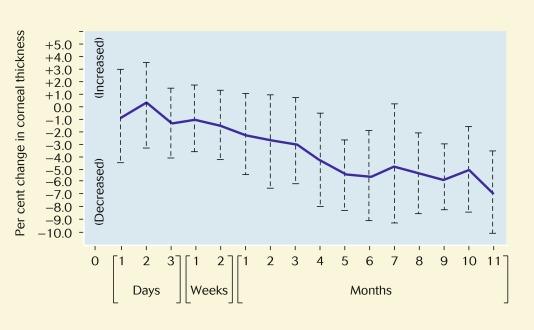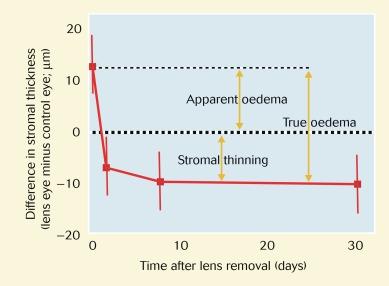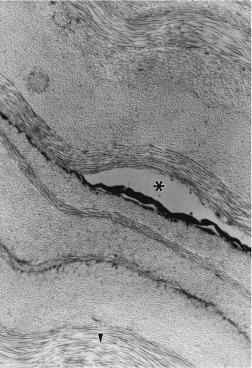Physical Address
304 North Cardinal St.
Dorchester Center, MA 02124
As discussed in Chapter 22 , stromal oedema is a reliable indicator of the level of hypoxic stress induced by contact lens wear. It is an acute response in that the oedema will increase to steady state within a few hours when the cornea is subjected to hypoxic stress and will return to baseline within a few hours of the hypoxic stress being removed. Of course, oedema can be considered to be chronic if a patient wears oedema-inducing lenses over long periods, but even in these circumstances, the oedema still resolves when the cornea is no longer subjected to hypoxia.
Stromal thinning is an insidious chronic change, which is often masked by acute lens-induced oedema. In fact, the only way that stromal thinning can be properly assessed is to measure stromal thickness after a long period of cessation of lens wear (at least 1 week). This chapter shall examine the phenomenon of contact lens–induced stromal thinning and consider its clinical implications.
Stromal thinning was identified and defined for the first time in 1985 by Holden et al., although this phenomenon had been observed anecdotally by earlier workers. For example, Millodot noted that the corneas of patients who had worn polymethyl methacrylate (PMMA) contact lenses on a daily wear basis for 10 to 21 years became thinner, after ceasing lens wear, compared with the corneas of a matched control group of non–lens wearers. Lebow and Plishka reported apparent corneal thinning in an 11-month longitudinal extended-wear study of 22 patients with myopia wearing low-Dk hydrogel contact lenses (Hydrocurve II, CIBA Vision) ( Fig. 23.1 ). These authors were unsure of the cause of the progressive decrease in corneal thickness over the course of their study. It was thought at the time that these changes may have represented either some form of physiological adaptation or a methodological artefact relating to the progressive drop-out of subjects exhibiting adverse responses that were partially or wholly characterised by excessive corneal oedema.

Schoessler and Barr monitored corneal thickness changes in eight patients with myopia wearing low-permeability (low-Dk) hydrogel contact lenses (Permalens, CooperVision) continuously for 18 months. The averaged results showed maximal corneal swelling after 1 week of wear, with the cornea gradually returning to near pre-fitting thickness levels. These authors noted that ‘some patients [showed] chronic corneal thickening and some [showed] corneal thinning after the 18-month wearing period’.
Holden et al. detected stromal thinning by measuring the presenting stromal thickness of patients who had been wearing a lens in one eye only on an extended-wear basis for an average of 5.2 ± 2.4 years. A lens was worn in one eye only in these patients because they were suffering from either unilateral myopia or amblyopia in the contralateral eye. Upon ceasing lens wear after 5.2 years, it was noted that the stroma in the lens-wearing eye decreased in thickness to a steady-state level that was thinner than the fellow non-lens-wearing eye ( Fig. 23.2 ).

Assuming that the stromal thickness of both eyes was the same before lens wear (this was validated in a non-lens-wearing control group of individuals with unilateral myopia and amblyopia), the only assumption that can be drawn is that contact lenses induce stromal thinning. It can be seen from Figure 23.2 that the stroma had thinned an average of 11 μm in 5.2 years of lens wear; representing an average of 2.1-μm thinning per year of lens wear. The revelation of stromal thinning by Holden et al. has facilitated interpretation of data from earlier longitudinal studies on lens wearing which had failed to take this phenomenon into account. The following equation, derived from Figure 23.2 , can be used to determine the extent of stromal thinning:
It is important for clinicians to recognise that the phenomenon of contact lens–induced stromal thinning does not confound or invalidate interpretation of the clinical signs of acute oedema discussed in Chapter 22 . The signs of striae, folds and haze represent a given level of acute oedema irrespective of whether or not the stroma has thinned; that is, these signs still indicate the level of true oedema.
Liu and Pflugfelder evaluated the effect of long-term contact lens wear on corneal thickness in 35 subjects who had been wearing contact lenses for 13.5 ± 6 years; these data were compared with data from 40 control eyes. Those authors observed that the mean corneal thickness in the centre and in eight peripheral areas measured in contact lens–wearing subjects was significantly reduced by about 30 to 50 μm compared with normal subjects and that these changes were unrelated to the degree of myopia.
Chang et al. compared corneal thickness in 34 subjects and 42 subjects who had been wearing daily-wear soft lenses for less than 5 years and more than 5 years, respectively. They noted a significant tendency towards corneal thinning with a longer history of contact lens wear (r = −0.31; p = 0.002). The results of Liu and Pflugfelder and Chang et al. support the original observation of Holden et al. – that long-term contact lens wear causes a decrease in corneal thickness.
Myrowitz et al. measured corneal thickness in 124 consecutive patients (248 eyes) who underwent comprehensive evaluations in consideration of refractive surgery. These authors observed that 39 patients (78 eyes) who had previously worn soft contact lenses for an average of 16 years had a mean corneal thickness of 543.2 ± 3.8 μm (standard error); 23 patients (46 eyes) who had worn rigid contact lenses for an average of 19 years had a mean corneal thickness of 509.4 ± 6.9 μm; and 62 patients (124 eyes) who had not previously worn contact lenses had a mean corneal thickness of 546.4 ± 3.5 μm. These authors concluded that long-term rigid contact lens wear is associated with a decrease in the average central corneal thickness of 37 μm compared with no contact lens wear. They were unable to confirm the earlier findings by Holden et al. and Liu and Pflugfelder that such an effect existed among soft-lens wearers.
Lei et al. measured corneal thickness in 56 subjects immediately after cessation of contact lens wear and 2 weeks later, as well as in 94 non-lens-wearing control subjects by using the RTVue-100 Fourier-domain anterior segment optical coherence tomography system. Corneal thickness in the control group was 534 ± 27 μm. Immediately after ceasing lens wear, corneal thickness was 529 ± 28 μm. Two weeks after ceasing lens wear, corneal thickness was 521 ± 26 μm; this value was significantly less than the corneal thickness immediately after ceasing lens wear and that of control corneal thickness. This finding suggests that normal, uncomplicated contact lens wear induces corneal thinning.
An important methodological issue needs to be taken into account when considering reported data of lens-induced corneal thinning. Holden et al. specifically measured stromal thickness, whereas all of the other researchers referred to earlier measured total corneal thickness; that is, the combined thickness of the stroma (typically 550 μm thick) and the epithelium (typically 50 μm thick). Long-term contact lens wear is also known to induce epithelial thinning; this is estimated to be 5.6% by Holden et al. and between 8.7% and 18.4% by Perez et al. Therefore, published estimates of stromal thinning may be confounded by effects of lens wear on the epithelial thickness.
Consider the results of Liu and Pflugfelder, who observed 40 μm of corneal thinning (taking the mid-point of their reported range of 30–50 μm thinning). Their subjects may also have suffered about 10% of epithelial thinning, or about 5 μm, assuming a 50-μm-thick epithelium. This would leave about 35 μm of stromal thinning, which represent about 2.6 μm/year of stromal thinning over the 13.5 years of lens wear of the subjects in the cohort of Liu and Pflugfelder. For the data of Myrowitz et al., 37 μm of corneal thinning in rigid lens wearers may equate to 32 μm of stromal thinning. The calculated rate of stromal thinning over the 19 years of lens wear is therefore 1.7 μm per year. In the case of Lei et al., subtracting the 2-week data from the control data gives 13 μm of corneal thinning and may equate to 8 μm of stromal thinning; however, a rate of stromal thinning cannot be determined in this case because Lei et al. did not report the length of time lenses had been worn.
The calculated stromal thinning rates of 2.1, 2.6 and 1.7 μm per year based on the data of Holden et al., Liu and Pflugfelder and Myrowitz et al., respectively, are remarkably similar.
None of the studies reporting stromal thinning has noted any symptomatic associations. However, should the stroma become so thin that corneal warpage takes place, some loss of visual function might be expected (see Chapter 28 ).
Of course, recognition that the stroma has become thinner is in itself a statement of pathological change, but further to this, subtle ultrastructural changes have been observed in the cornea as a result of contact lens wear. These changes may offer valuable insights into the process of stromal thinning.
A good starting point for considering lens-induced structural changes that may be of relevance to stromal thinning is to note the critical role of stromal keratocytes in the synthesis and maintenance of the collagen and extracellular matrix that comprise the bulk of the stroma. Any disruption to the capacity of keratocytes to function normally might be expected to compromise the structural integrity of the cornea. Specifically, if keratocytes are not laying down and maintaining the collagen and extracellular matrix, then there will be a gradual reduction in tissue mass, which may manifest as stromal thinning.
In a primate model, Bergmanson and Chu found that PMMA lens wear induces changes in stromal keratocytes, including the formation of clear zones around the keratocytes along with spaces filled with granular tissue ( Fig. 23.3 ). The theoretical background outlined earlier, coupled with the experimental observations of Bergmanson and Chu, highlighted the need to focus attention on the effect of contact lens wear on stromal keratocytes in human subjects; however, keratocytes are beyond the resolution of the slit lamp biomicroscope, precluding clinical studies using this instrument. It is only through the development of the corneal confocal microscope in the 1990s that the monitoring of keratocytes in the corneas of human subjects has been possible.

Become a Clinical Tree membership for Full access and enjoy Unlimited articles
If you are a member. Log in here